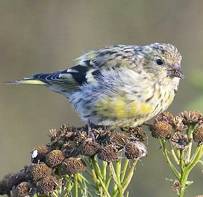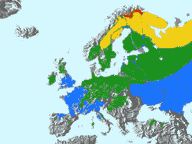Sisken
/ Zeisig,
Erlenzeisig / Carduelis
spinus
Finken
Fringillidae
Weighing just 13 - 15 grams this is a well-known bird.
Not because he is so often seen in nature, but because he is a popular
caged bird. Earlier, they were available in most pet shops. Due to their
social nature, they are easily and quickly tamed. Even wild birds become
tame, bringing the bird-lover much enjoyment. The siskin can be long-lived
as well. I know one owner who has had a bird for fourteen years.
The
male is easily distinguished from other green finches by his black
forehead and bib. The siskin nests mostly in mountainous
regions where they prefer tall firs or other evergreens. The nest is
built on
side branches of tree tops, a weave of fine roots, twigs, webs and moss.
The nest is very well camouflaged, making it almost impossible to find.
he nest is lined with plant silk, hairs, and feathers.
The female chooses the nesting site, brings the materials, and builds
the nest alone. The male sings, brings food, and grooms and feeds the
female. He also has a curious mating flight. While singing, he flies
high over the treetop, and makes several circles with puffed out feathers
and spread tail. Meanwhile, he flaps his wings so high, that they smack
together over his body. The siskin has two broods per year, in April
and in June. Each time the female lays 4-6 bluish-white eggs, which are
lightly speckled with red-brown. The female does all of the brooding,
and the male feeds her from his crop.
After 13 days the young hatch, and are fed tender insects, followed later
by seed which is first softened in the parents' crop. At 13 - 15 days
the young leave the nest. The siskin song is well known to bird lovers,
and some males imitate other birds' songs as well. The males sing not
only during courting, as many related birds do, but also throughout the
year, except during the moult. This quality has contributed greatly to
the bird's popularity.
After nesting, usually sometime in August the siskins from large flocks,
and their calls make them obvious. They are to be found everywhere that
elder, birch, and similar seeds are present. They climb and often hang
head-down to extract the seeds. They flock often with redpolls that overwinter
in Germany, and in colder weather feed on buds. In May they give up the
gypsy life and return to their breeding grounds.
Care and breeding:
The siskin begins breeding very early. The female begins building the
nest at the end of February or beginning of March, laying one egg a
day until 3-6 eggs are in the nest. The female incubates the eggs alone
for 11-13 days, during which time she is fed by the male. The babies
stay in the nest for 11-14 days, but continue to be fed for another
10 days. Siskins are excellent for beginners. While feeding the young,
a diet including a wide variety of greens, aphids, and mealworms is
important. A good wild bird mix consisting of different wildseed
should of course always be available. I also provide poppy seed in
a separate feeder.
Status in Britain:
Fairly widespread resident and winter visitor. Has increased in the last
thirty years or so due to conifer plantations.
PINE SISKIN
Spinus Pinus
Three subspecies:
Spinus pinus macropterus - N. Baja California to north E. & C. Mexico
Spinus pinus perplexus - S. Mexico to Guatemala
Spinus pinus pinus - Canada, USA & C. Mexico
This brownish bird is heavily streaked with gray and black, with black being on its primary flights and tail feathers. Pine Siskins are about the size of the European Siskins. They adapt well and will breed freely in captivity. Over the years I have been trying to obtain information about the three subspecies and their difference in size and color but no one seems to know, even some Ornithological Societies and Museums could not give me the answer. There's no need to emphasize that information about smaller birds is more often not available, but for some reason all information needed is always there about the larger birds like the Eagles and Macaws.
|
|







